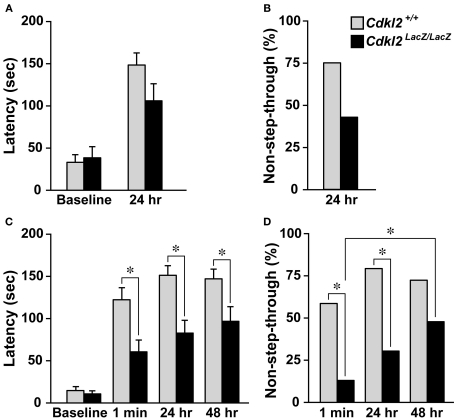Figure 4.
Inhibitory avoidance test. When the animals had stepped with all four paws into the dark compartment, the door was closed and the baseline latency was recorded. The animals were given a single footshock (0.4 mA for 5 s) and then placed in their home cages. Retention was tested by placing the mice in the lighted compartment and measuring the latency to enter the dark compartment. (A) Step-through latencies to enter the dark compartment were measured 24 h after footshock. Statistical analysis was performed using the Mann-Whitney U-test. The baseline latencies were not significantly different between genotypes (U = 102.5, P = 0.6926). In the 24-h retention trials, Cdkl2LacZ/LacZ mice exhibited reduced latencies, but the difference was not significant (U = 74.0, P = 0.0745). (B) The percentage of mice that did not enter the dark compartment (non-step-through) in 24-h retention trials was plotted. A chi-square test revealed that there was no significant difference in percent non-step-through between Cdkl2+/+mice and Cdkl2LacZ/LacZ mice (χ2 = 3.214, P = 0.0730). (C) Step-through latencies were measured 1 min, 24 h, and 48 h after footshock. The baseline latencies were not significantly different between genotypes (U = 258.5, P = 0.1670). In the retention trials, Cdkl2LacZ/LacZ mice exhibited significantly reduced latencies at 1 min and 24 h after footshock (1 min, U = 181.5, P = 0.0051, 24 h, U = 163.5, P = 0.0017 and 48 h, U = 218.5, P = 0.0341). (D) The percentage of non-step-through Cdkl2LacZ/LacZ mice was significantly different between 1 min and 24 h (1 min, χ2 = 11.258, P = 0.0008 and 24 h, χ2 = 12.554, P = 0.0004). In Cdkl2LacZ/LacZ mice, the percentage of non-step-through was significantly higher in the 48-h retention test compared to the 1-min retention test (χ2 = 6.571, P = 0.0104).

